cruise control NISSAN 370Z ROADSTER 2011 Owners Manual
[x] Cancel search | Manufacturer: NISSAN, Model Year: 2011, Model line: 370Z ROADSTER, Model: NISSAN 370Z ROADSTER 2011Pages: 419, PDF Size: 3.61 MB
Page 18 of 419
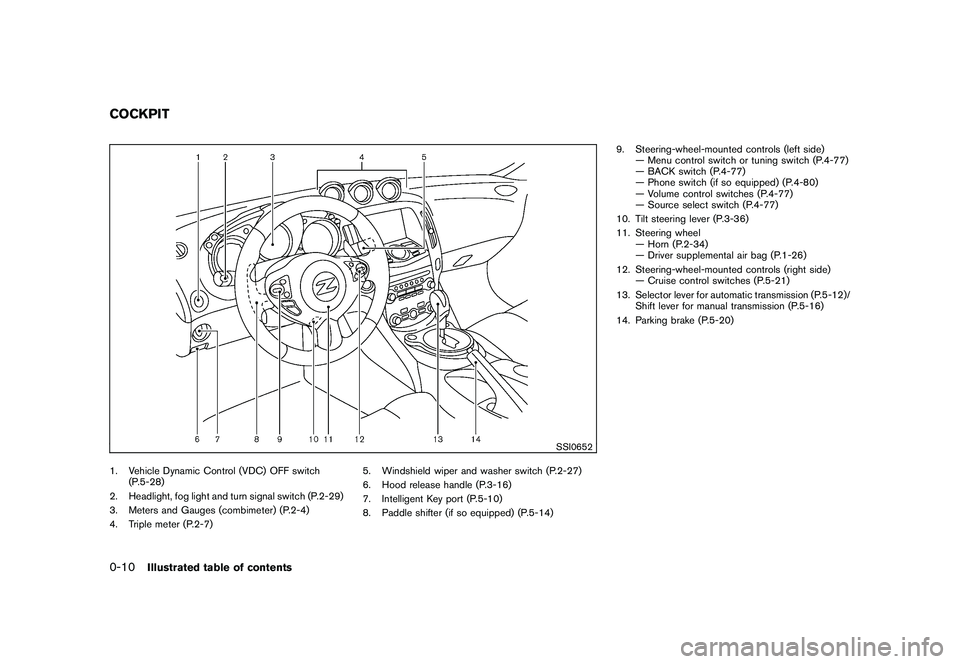
Black plate (12,1)
Model "Z34-D" EDITED: 2010/ 7/ 27
SSI0652
1. Vehicle Dynamic Control (VDC) OFF switch(P.5-28)
2. Headlight, fog light and turn signal switch (P.2-29)
3. Meters and Gauges (combimeter) (P.2-4)
4. Triple meter (P.2-7) 5. Windshield wiper and washer switch (P.2-27)
6. Hood release handle (P.3-16)
7. Intelligent Key port (P.5-10)
8. Paddle shifter (if so equipped) (P.5-14)9. Steering-wheel-mounted controls (left side)
— Menu control switch or tuning switch (P.4-77)
— BACK switch (P.4-77)
— Phone switch (if so equipped) (P.4-80)
— Volume control switches (P.4-77)
— Source select switch (P.4-77)
10. Tilt steering lever (P.3-36)
11. Steering wheel — Horn (P.2-34)
— Driver supplemental air bag (P.1-26)
12. Steering-wheel-mounted controls (right side) — Cruise control switches (P.5-21)
13. Selector lever for automatic transmission (P.5-12)/ Shift lever for manual transmission (P.5-16)
14. Parking brake (P.5-20)COCKPIT0-10
Illustrated table of contents
Page 22 of 419
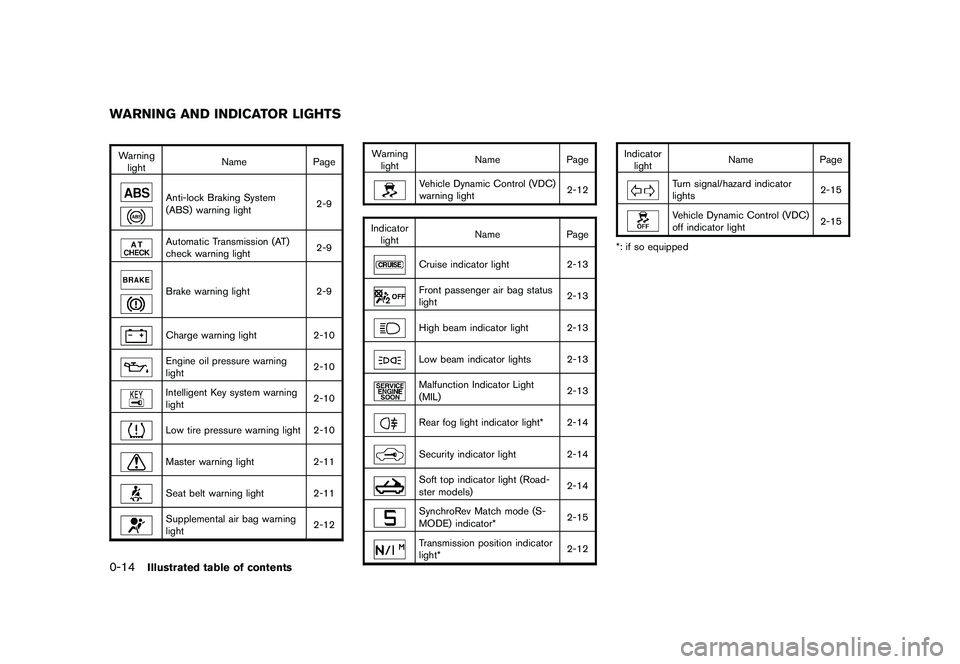
Black plate (16,1)
Model "Z34-D" EDITED: 2010/ 7/ 27
Warninglight Name
Page
Anti-lock Braking System
(ABS) warning light 2-9Automatic Transmission (AT)
check warning light2-9Brake warning light
2-9Charge warning light2-10Engine oil pressure warning
light 2-10Intelligent Key system warning
light2-10Low tire pressure warning light 2-10Master warning light
2-11Seat belt warning light 2-11Supplemental air bag warning
light 2-12Warning
light Name
Page
Vehicle Dynamic Control (VDC)
warning light 2-12
Indicator light Name PageCruise indicator light
2-13Front passenger air bag status
light 2-13High beam indicator light 2-13Low beam indicator lights 2-13Malfunction Indicator Light
(MIL)2-13Rear fog light indicator light* 2-14Security indicator light
2-14Soft top indicator light (Road-
ster models) 2-14SynchroRev Match mode (S-
MODE) indicator*2-15Transmission position indicator
light*2-12Indicator
light Name Page
Turn signal/hazard indicator
lights 2-15Vehicle Dynamic Control (VDC)
off indicator light
2-15
*: if so equipped
WARNING AND INDICATOR LIGHTS0-14
Illustrated table of contents
Page 64 of 419
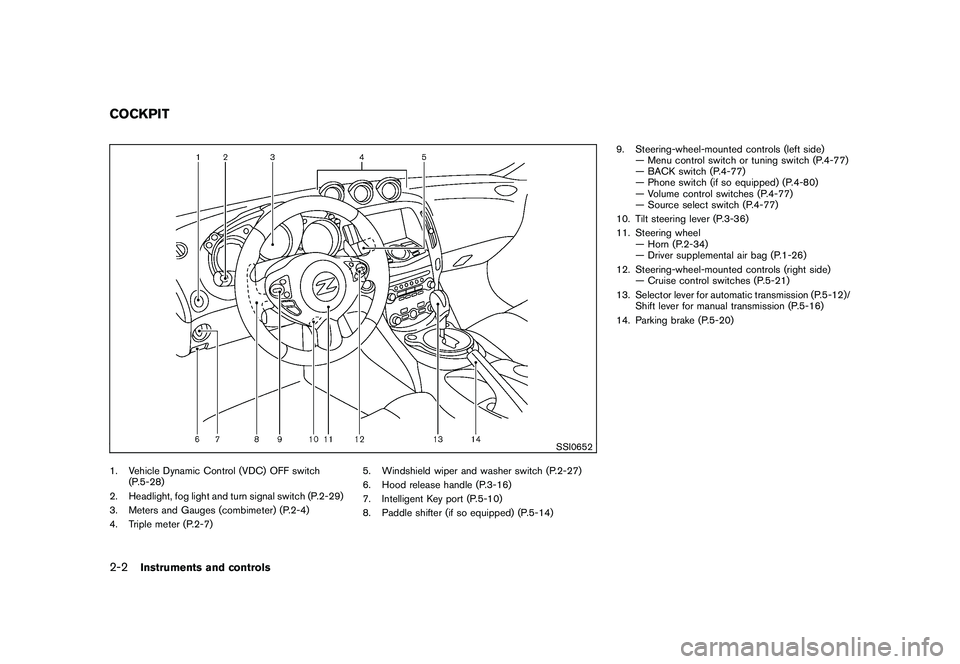
Black plate (60,1)
Model "Z34-D" EDITED: 2010/ 7/ 27
SSI0652
1. Vehicle Dynamic Control (VDC) OFF switch(P.5-28)
2. Headlight, fog light and turn signal switch (P.2-29)
3. Meters and Gauges (combimeter) (P.2-4)
4. Triple meter (P.2-7) 5. Windshield wiper and washer switch (P.2-27)
6. Hood release handle (P.3-16)
7. Intelligent Key port (P.5-10)
8. Paddle shifter (if so equipped) (P.5-14)9. Steering-wheel-mounted controls (left side)
— Menu control switch or tuning switch (P.4-77)
— BACK switch (P.4-77)
— Phone switch (if so equipped) (P.4-80)
— Volume control switches (P.4-77)
— Source select switch (P.4-77)
10. Tilt steering lever (P.3-36)
11. Steering wheel — Horn (P.2-34)
— Driver supplemental air bag (P.1-26)
12. Steering-wheel-mounted controls (right side) — Cruise control switches (P.5-21)
13. Selector lever for automatic transmission (P.5-12)/ Shift lever for manual transmission (P.5-16)
14. Parking brake (P.5-20)COCKPIT2-2
Instruments and controls
Page 70 of 419
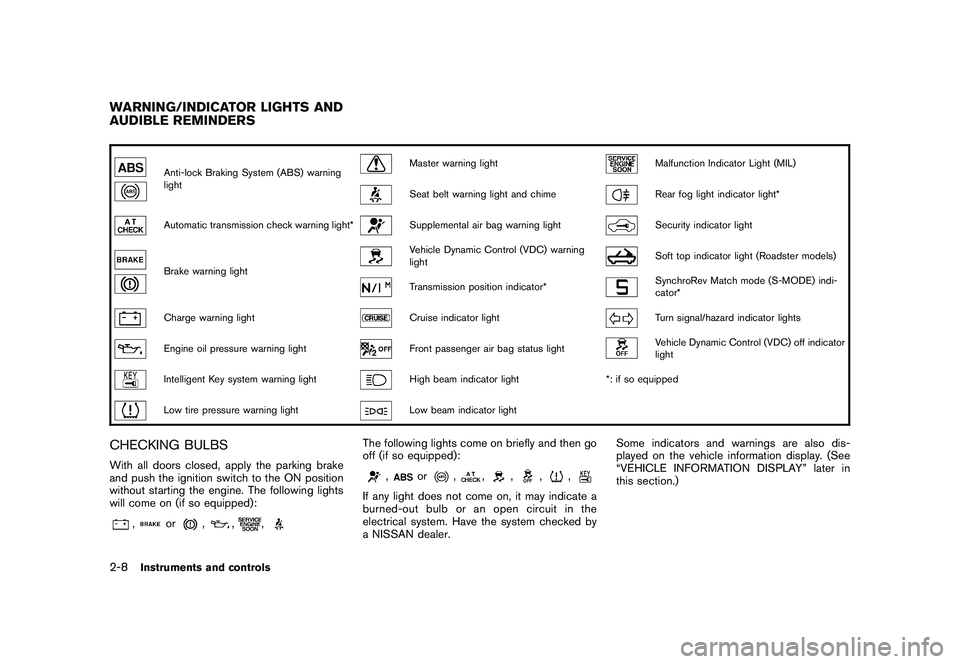
Black plate (66,1)
Model "Z34-D" EDITED: 2010/ 7/ 27
Anti-lock Braking System (ABS) warning
light
Master warning light
Malfunction Indicator Light (MIL)
Seat belt warning light and chime
Rear fog light indicator light*
Automatic transmission check warning light*
Supplemental air bag warning light
Security indicator light
Brake warning light
Vehicle Dynamic Control (VDC) warning
light
Soft top indicator light (Roadster models)
Transmission position indicator*
SynchroRev Match mode (S-MODE) indi-
cator*
Charge warning light
Cruise indicator light
Turn signal/hazard indicator lights
Engine oil pressure warning light
Front passenger air bag status light
Vehicle Dynamic Control (VDC) off indicator
light
Intelligent Key system warning light
High beam indicator light*: if so equipped
Low tire pressure warning light
Low beam indicator light
CHECKING BULBSWith all doors closed, apply the parking brake
and push the ignition switch to the ON position
without starting the engine. The following lights
will come on (if so equipped):
,
or
,
,
,
The following lights come on briefly and then go
off (if so equipped):
,
or
,
,
,
,
,
If any light does not come on, it may indicate a
burned-out bulb or an open circuit in the
electrical system. Have the system checked by
a NISSAN dealer. Some indicators and warnings are also dis-
played on the vehicle information display. (See
“VEHICLE INFORMATION DISPLAY” later in
this section.)
WARNING/INDICATOR LIGHTS AND
AUDIBLE REMINDERS2-8
Instruments and controls
Page 75 of 419
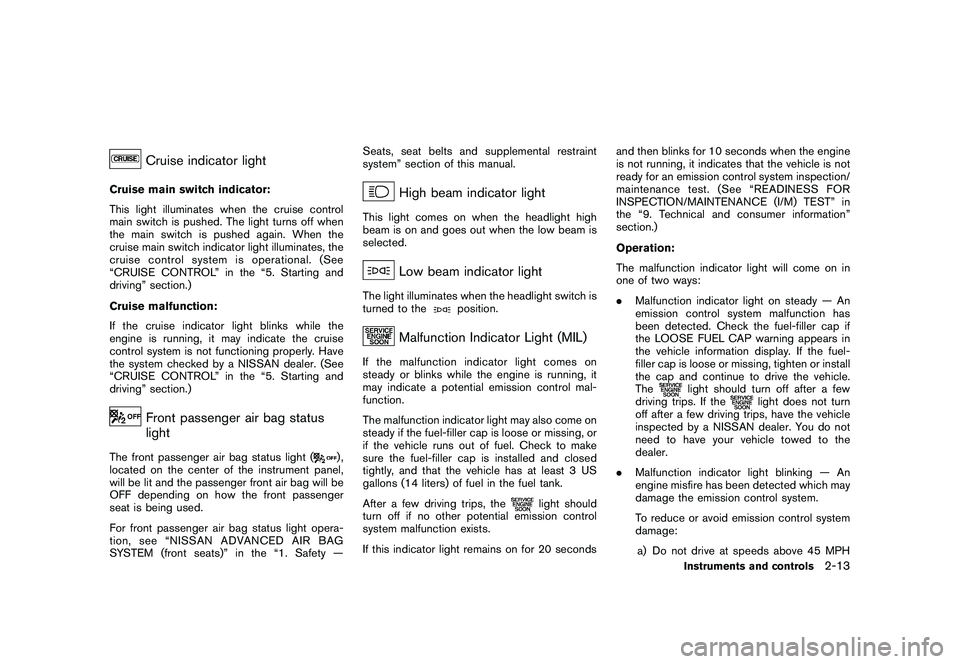
Black plate (71,1)
Model "Z34-D" EDITED: 2010/ 7/ 27
Cruise indicator light
Cruise main switch indicator:
This light illuminates when the cruise control
main switch is pushed. The light turns off when
the main switch is pushed again. When the
cruise main switch indicator light illuminates, the
cruise control system is operational. (See
“CRUISE CONTROL” in the “5. Starting and
driving” section.)
Cruise malfunction:
If the cruise indicator light blinks while the
engine is running, it may indicate the cruise
control system is not functioning properly. Have
the system checked by a NISSAN dealer. (See
“CRUISE CONTROL” in the “5. Starting and
driving” section.)
Front passenger air bag status
light
The front passenger air bag status light (
),
located on the center of the instrument panel,
will be lit and the passenger front air bag will be
OFF depending on how the front passenger
seat is being used.
For front passenger air bag status light opera-
tion,see“NISSANADVANCEDAIRBAG
SYSTEM (front seats)” in the “1. Safety — Seats, seat belts and supplemental restraint
system” section of this manual.
High beam indicator light
This light comes on when the headlight high
beam is on and goes out when the low beam is
selected.
Low beam indicator light
The light illuminates when the headlight switch is
turned to the
position.
Malfunction Indicator Light (MIL)
If the malfunction indicator light comes on
steady or blinks while the engine is running, it
may indicate a potential emission control mal-
function.
The malfunction indicator light may also come on
steady if the fuel-filler cap is loose or missing, or
if the vehicle runs out of fuel. Check to make
sure the fuel-filler cap is installed and closed
tightly, and that the vehicle has at least 3 US
gallons (14 liters) of fuel in the fuel tank.
After a few driving trips, the
light should
turn off if no other potential emission control
system malfunction exists.
If this indicator light remains on for 20 seconds and then blinks for 10 seconds when the engine
is not running, it indicates that the vehicle is not
ready for an emission control system inspection/
maintenance test. (See “READINESS FOR
INSPECTION/MAINTENANCE (I/M) TEST” in
the “9. Technical and consumer information”
section.)
Operation:
The malfunction indicator light will come on in
one of two ways:
.
Malfunction indicator light on steady — An
emission control system malfunction has
been detected. Check the fuel-filler cap if
the LOOSE FUEL CAP warning appears in
the vehicle information display. If the fuel-
filler cap is loose or missing, tighten or install
the cap and continue to drive the vehicle.
The
light should turn off after a few
driving trips. If the
light does not turn
off after a few driving trips, have the vehicle
inspected by a NISSAN dealer. You do not
need to have your vehicle towed to the
dealer.
. Malfunction indicator light blinking — An
engine misfire has been detected which may
damage the emission control system.
To reduce or avoid emission control system
damage:
a) Do not drive at speeds above 45 MPH
Instruments and controls
2-13
Page 283 of 419
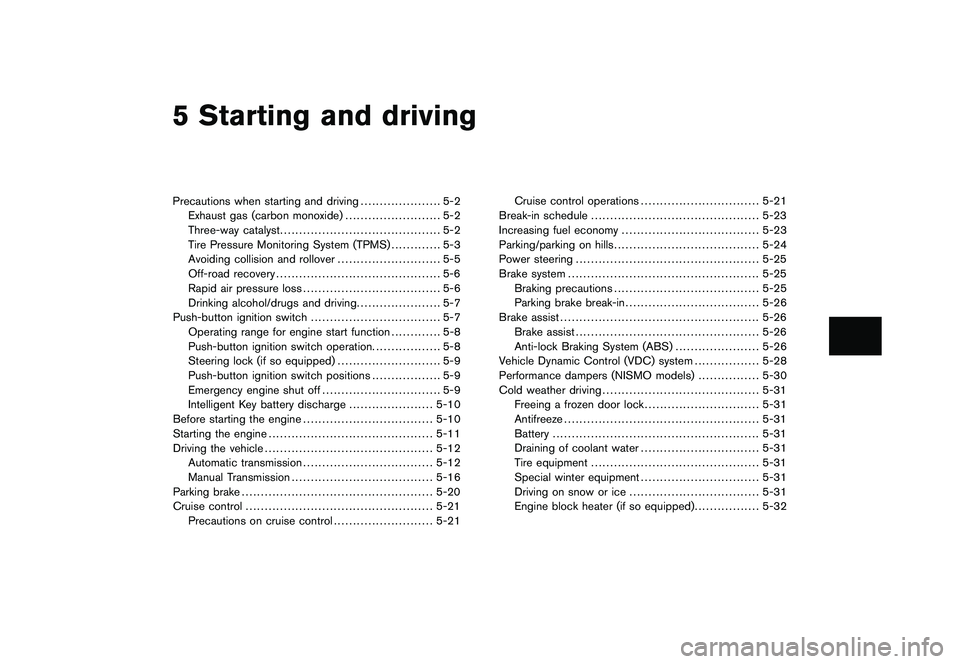
Black plate (16,1)
5 Starting and driving
Model "Z34-D" EDITED: 2010/ 7/ 28
Precautions when starting and driving..................... 5-2
Exhaust gas (carbon monoxide) ......................... 5-2
Three-way catalyst .......................................... 5-2
Tire Pressure Monitoring System (TPMS) ............. 5-3
Avoiding collision and rollover ........................... 5-5
Off-road recovery ........................................... 5-6
Rapid air pressure loss .................................... 5-6
Drinking alcohol/drugs and driving ...................... 5-7
Push-button ignition switch .................................. 5-7
Operating range for engine start function ............. 5-8
Push-button ignition switch operation. ................. 5-8
Steering lock (if so equipped) ........................... 5-9
Push-button ignition switch positions .................. 5-9
Emergency engine shut off ............................... 5-9
Intelligent Key battery discharge ...................... 5-10
Before starting the engine .................................. 5-10
Starting the engine ........................................... 5-11
Driving the vehicle ............................................ 5-12
Automatic transmission .................................. 5-12
Manual Transmission ..................................... 5-16
Parking brake .................................................. 5-20
Cruise control ................................................. 5-21
Precautions on cruise control .......................... 5-21 Cruise control operations
............................... 5-21
Break-in schedule ............................................ 5-23
Increasing fuel economy .................................... 5-23
Parking/parking on hills ...................................... 5-24
Power steering ................................................ 5-25
Brake system .................................................. 5-25
Braking precautions ...................................... 5-25
Parking brake break-in ................................... 5-26
Brake assist .................................................... 5-26
Brake assist ................................................ 5-26
Anti-lock Braking System (ABS) ...................... 5-26
Vehicle Dynamic Control (VDC) system ................. 5-28
Performance dampers (NISMO models) ................ 5-30
Cold weather driving ......................................... 5-31
Freeing a frozen door lock .............................. 5-31
Antifreeze ................................................... 5-31
Battery ...................................................... 5-31
Draining of coolant water ............................... 5-31
Tire equipment ............................................ 5-31
Special winter equipment ............................... 5-31
Driving on snow or ice .................................. 5-31
Engine block heater (if so equipped) ................. 5-32
Page 303 of 419
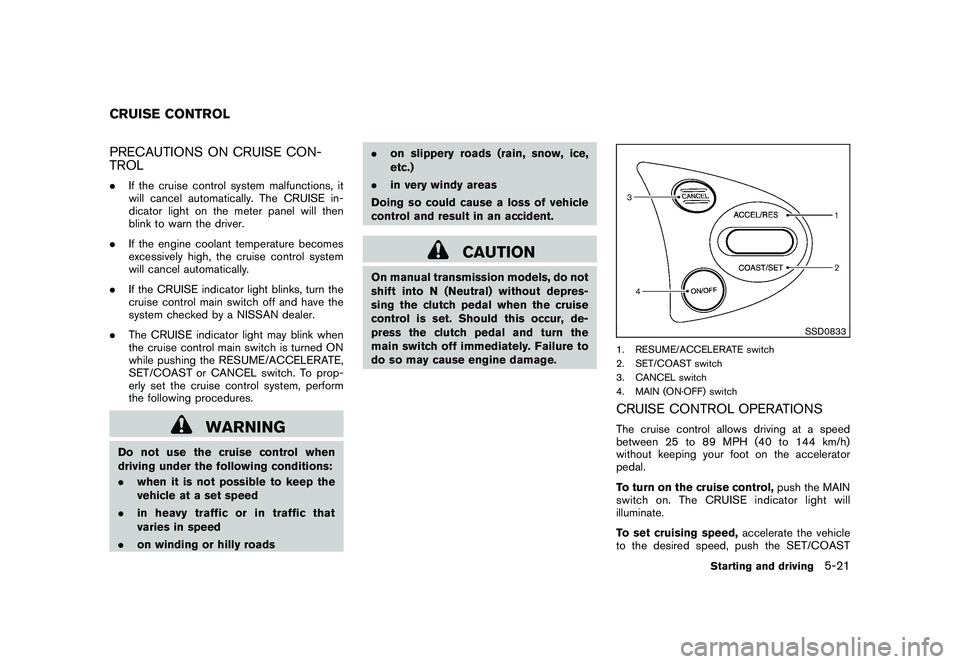
Black plate (299,1)
Model "Z34-D" EDITED: 2010/ 7/ 27
PRECAUTIONS ON CRUISE CON-
TROL.If the cruise control system malfunctions, it
will cancel automatically. The CRUISE in-
dicator light on the meter panel will then
blink to warn the driver.
. If the engine coolant temperature becomes
excessively high, the cruise control system
will cancel automatically.
. If the CRUISE indicator light blinks, turn the
cruise control main switch off and have the
system checked by a NISSAN dealer.
. The CRUISE indicator light may blink when
the cruise control main switch is turned ON
while pushing the RESUME/ACCELERATE,
SET/COAST or CANCEL switch. To prop-
erly set the cruise control system, perform
the following procedures.
WARNING
Do not use the cruise control when
driving under the following conditions:
.when it is not possible to keep the
vehicle at a set speed
. in heavy traffic or in traffic that
varies in speed
. on winding or hilly roads .
on slippery roads (rain, snow, ice,
etc.)
. in very windy areas
Doing so could cause a loss of vehicle
control and result in an accident.
CAUTION
On manual transmission models, do not
shift into N (Neutral) without depres-
sing the clutch pedal when the cruise
control is set. Should this occur, de-
press the clutch pedal and turn the
main switch off immediately. Failure to
do so may cause engine damage.
SSD0833
1. RESUME/ACCELERATE switch
2. SET/COAST switch
3. CANCEL switch
4. MAIN (ON·OFF) switchCRUISE CONTROL OPERATIONSThe cruise control allows driving at a speed
between 25 to 89 MPH (40 to 144 km/h)
without keeping your foot on the accelerator
pedal.
To turn on the cruise control, push the MAIN
switch on. The CRUISE indicator light will
illuminate.
To set cruising speed, accelerate the vehicle
to the desired speed, push the SET/COAST
CRUISE CONTROL
Starting and driving
5-21
Page 304 of 419
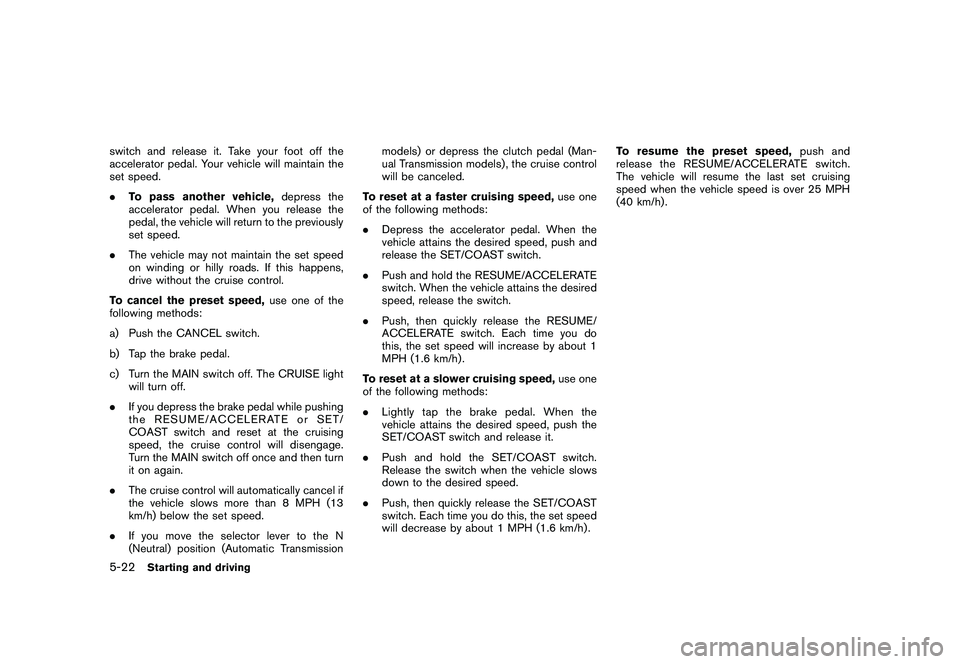
Black plate (300,1)
Model "Z34-D" EDITED: 2010/ 7/ 27
switch and release it. Take your foot off the
accelerator pedal. Your vehicle will maintain the
set speed.
.To pass another vehicle, depress the
accelerator pedal. When you release the
pedal, the vehicle will return to the previously
set speed.
. The vehicle may not maintain the set speed
on winding or hilly roads. If this happens,
drive without the cruise control.
To cancel the preset speed, use one of the
following methods:
a) Push the CANCEL switch.
b) Tap the brake pedal.
c) Turn the MAIN switch off. The CRUISE light will turn off.
. If you depress the brake pedal while pushing
the RESUME/ACCELERATE or SET/
COAST switch and reset at the cruising
speed, the cruise control will disengage.
Turn the MAIN switch off once and then turn
it on again.
. The cruise control will automatically cancel if
the vehicle slows more than 8 MPH (13
km/h) below the set speed.
. If you move the selector lever to the N
(Neutral) position (Automatic Transmission models) or depress the clutch pedal (Man-
ual Transmission models), the cruise control
will be canceled.
To reset at a faster cruising speed, use one
of the following methods:
. Depress the accelerator pedal. When the
vehicle attains the desired speed, push and
release the SET/COAST switch.
. Push and hold the RESUME/ACCELERATE
switch. When the vehicle attains the desired
speed, release the switch.
. Push, then quickly release the RESUME/
ACCELERATE switch. Each time you do
this, the set speed will increase by about 1
MPH (1.6 km/h) .
To reset at a slower cruising speed, use one
of the following methods:
. Lightly tap the brake pedal. When the
vehicle attains the desired speed, push the
SET/COAST switch and release it.
. Push and hold the SET/COAST switch.
Release the switch when the vehicle slows
down to the desired speed.
. Push, then quickly release the SET/COAST
switch. Each time you do this, the set speed
will decrease by about 1 MPH (1.6 km/h) . To resume the preset speed,
push and
release the RESUME/ACCELERATE switch.
The vehicle will resume the last set cruising
speed when the vehicle speed is over 25 MPH
(40 km/h) .5-22
Starting and driving
Page 314 of 419
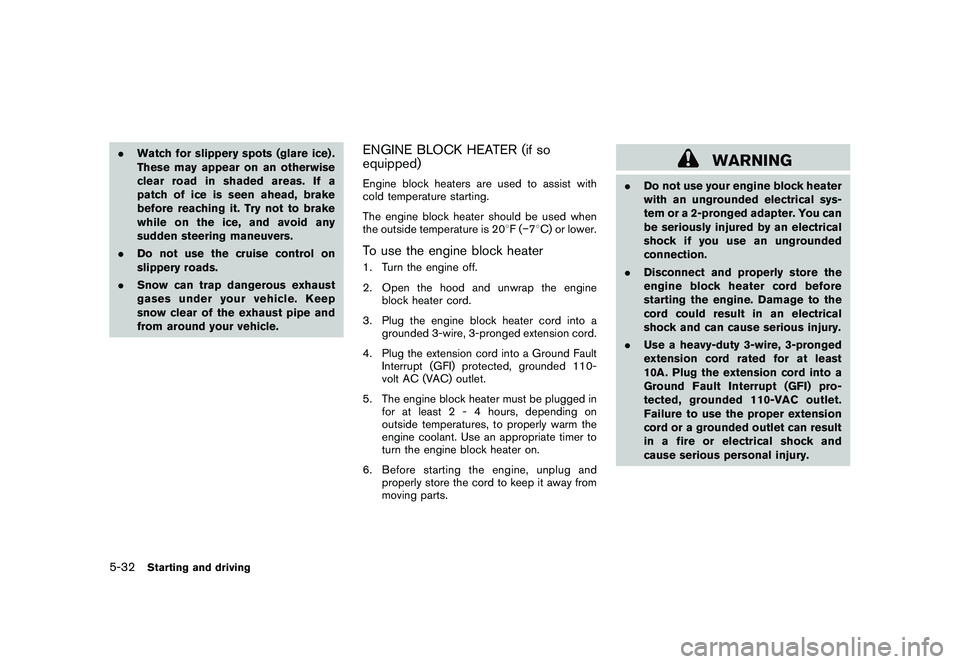
Black plate (310,1)
Model "Z34-D" EDITED: 2010/ 7/ 27
.Watch for slippery spots (glare ice) .
These may appear on an otherwise
clear road in shaded areas. If a
patch of ice is seen ahead, brake
before reaching it. Try not to brake
while on the ice, and avoid any
sudden steering maneuvers.
. Do not use the cruise control on
slippery roads.
. Snow can trap dangerous exhaust
gases under your vehicle. Keep
snow clear of the exhaust pipe and
from around your vehicle.
ENGINE BLOCK HEATER (if so
equipped)Engine block heaters are used to assist with
cold temperature starting.
The engine block heater should be used when
the outside temperature is 20 8F( �7 8C) or lower.To use the engine block heater1. Turn the engine off.
2. Open the hood and unwrap the engine
block heater cord.
3. Plug the engine block heater cord into a grounded 3-wire, 3-pronged extension cord.
4. Plug the extension cord into a Ground Fault Interrupt (GFI) protected, grounded 110-
volt AC (VAC) outlet.
5. The engine block heater must be plugged in for at least 2 - 4 hours, depending on
outside temperatures, to properly warm the
engine coolant. Use an appropriate timer to
turn the engine block heater on.
6. Before starting the engine, unplug and properly store the cord to keep it away from
moving parts.
WARNING
.Do not use your engine block heater
with an ungrounded electrical sys-
tem or a 2-pronged adapter. You can
be seriously injured by an electrical
shock if you use an ungrounded
connection.
. Disconnect and properly store the
engine block heater cord before
starting the engine. Damage to the
cord could result in an electrical
shock and can cause serious injury.
. Use a heavy-duty 3-wire, 3-pronged
extension cord rated for at least
10A. Plug the extension cord into a
Ground Fault Interrupt (GFI) pro-
tected, grounded 110-VAC outlet.
Failure to use the proper extension
cord or a grounded outlet can result
in a fire or electrical shock and
cause serious personal injury.
5-32
Starting and driving
Page 412 of 419
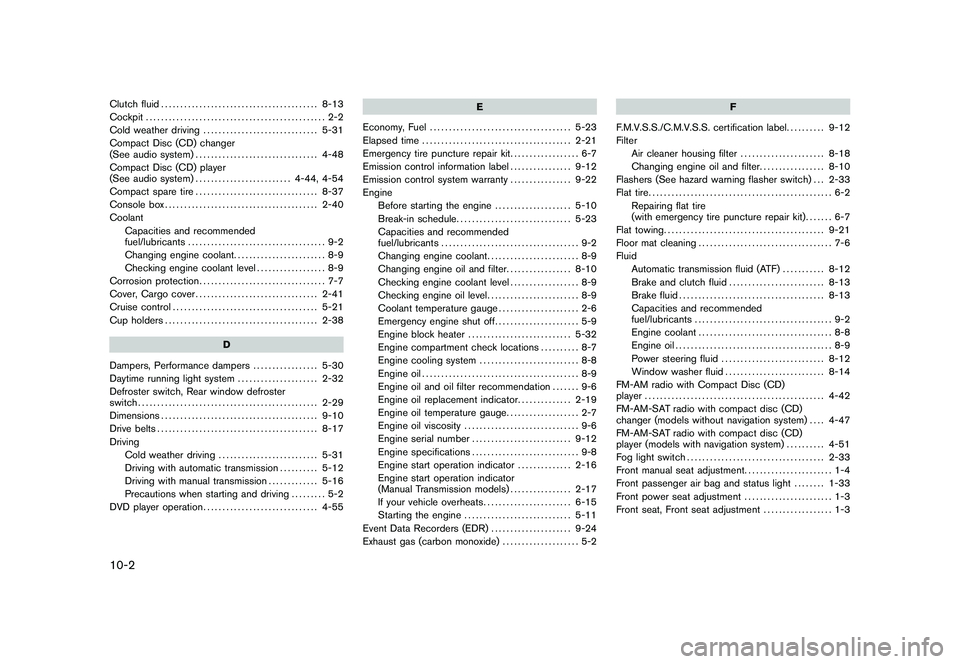
Black plate (2,1)
10-2Clutch fluid......................................... 8-13
Cockpit ............................................... 2-2
Cold weather driving .............................. 5-31
Compact Disc (CD) changer
(See audio system) ................................ 4-48
Compact Disc (CD) player
(See audio system) ......................... 4-44, 4-54
Compact spare tire ................................ 8-37
Console box ........................................ 2-40
Coolant Capacities and recommended
fuel/lubricants .................................... 9-2
Changing engine coolant ........................ 8-9
Checking engine coolant level .................. 8-9
Corrosion protection ................................. 7-7
Cover, Cargo cover ................................ 2-41
Cruise control ...................................... 5-21
Cup holders ........................................ 2-38
D
Dampers, Performance dampers ................. 5-30
Daytime running light system ..................... 2-32
Defroster switch, Rear window defroster
switch ............................................... 2-29
Dimensions ......................................... 9-10
Drive belts .......................................... 8-17
Driving Cold weather driving .......................... 5-31
Driving with automatic transmission .......... 5-12
Driving with manual transmission ............. 5-16
Precautions when starting and driving ......... 5-2
DVD player operation .............................. 4-55 E
Economy, Fuel ..................................... 5-23
Elapsed time ....................................... 2-21
Emergency tire puncture repair kit .................. 6-7
Emission control information label ................ 9-12
Emission control system warranty ................ 9-22
Engine Before starting the engine .................... 5-10
Break-in schedule .............................. 5-23
Capacities and recommended
fuel/lubricants .................................... 9-2
Changing engine coolant ........................ 8-9
Changing engine oil and filter ................. 8-10
Checking engine coolant level .................. 8-9
Checking engine oil level ........................ 8-9
Coolant temperature gauge ..................... 2-6
Emergency engine shut off ...................... 5-9
Engine block heater ........................... 5-32
Engine compartment check locations .......... 8-7
Engine cooling system .......................... 8-8
Engine oil ......................................... 8-9
Engine oil and oil filter recommendation ....... 9-6
Engine oil replacement indicator .............. 2-19
Engine oil temperature gauge ................... 2-7
Engine oil viscosity .............................. 9-6
Engine serial number .......................... 9-12
Engine specifications ............................ 9-8
Engine start operation indicator .............. 2-16
Engine start operation indicator
(Manual Transmission models) ................ 2-17
If your vehicle overheats ....................... 6-15
Starting the engine ............................ 5-11
Event Data Recorders (EDR) ..................... 9-24
Exhaust gas (carbon monoxide) .................... 5-2 F
F.M.V.S.S./C.M.V.S.S. certification label. ......... 9-12
Filter Air cleaner housing filter ...................... 8-18
Changing engine oil and filter ................. 8-10
Flashers (See hazard warning flasher switch) . . . 2-33
Flat tire ................................................ 6-2
Repairing flat tire
(with emergency tire puncture repair kit) ....... 6-7
Flat towing .......................................... 9-21
Floor mat cleaning ................................... 7-6
Fluid Automatic transmission fluid (ATF) ........... 8-12
Brake and clutch fluid ......................... 8-13
Brake fluid ...................................... 8-13
Capacities and recommended
fuel/lubricants .................................... 9-2
Engine coolant ................................... 8-8
Engine oil ......................................... 8-9
Power steering fluid ........................... 8-12
Window washer fluid .......................... 8-14
FM-AM radio with Compact Disc (CD)
player ............................................... 4-42
FM-AM-SAT radio with compact disc (CD)
changer (models without navigation system) .... 4-47
FM-AM-SAT radio with compact disc (CD)
player (models with navigation system) .......... 4-51
Fog light switch .................................... 2-33
Front manual seat adjustment. ...................... 1-4
Front passenger air bag and status light ........ 1-33
Front power seat adjustment ....................... 1-3
Front seat, Front seat adjustment .................. 1-3
Model "Z34-D" EDITED: 2010/ 7/ 28